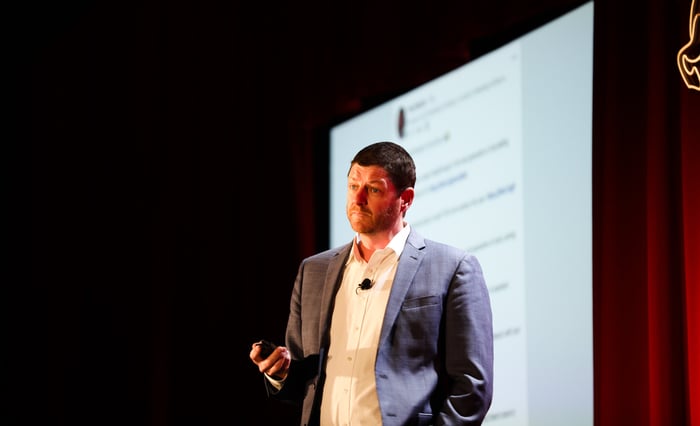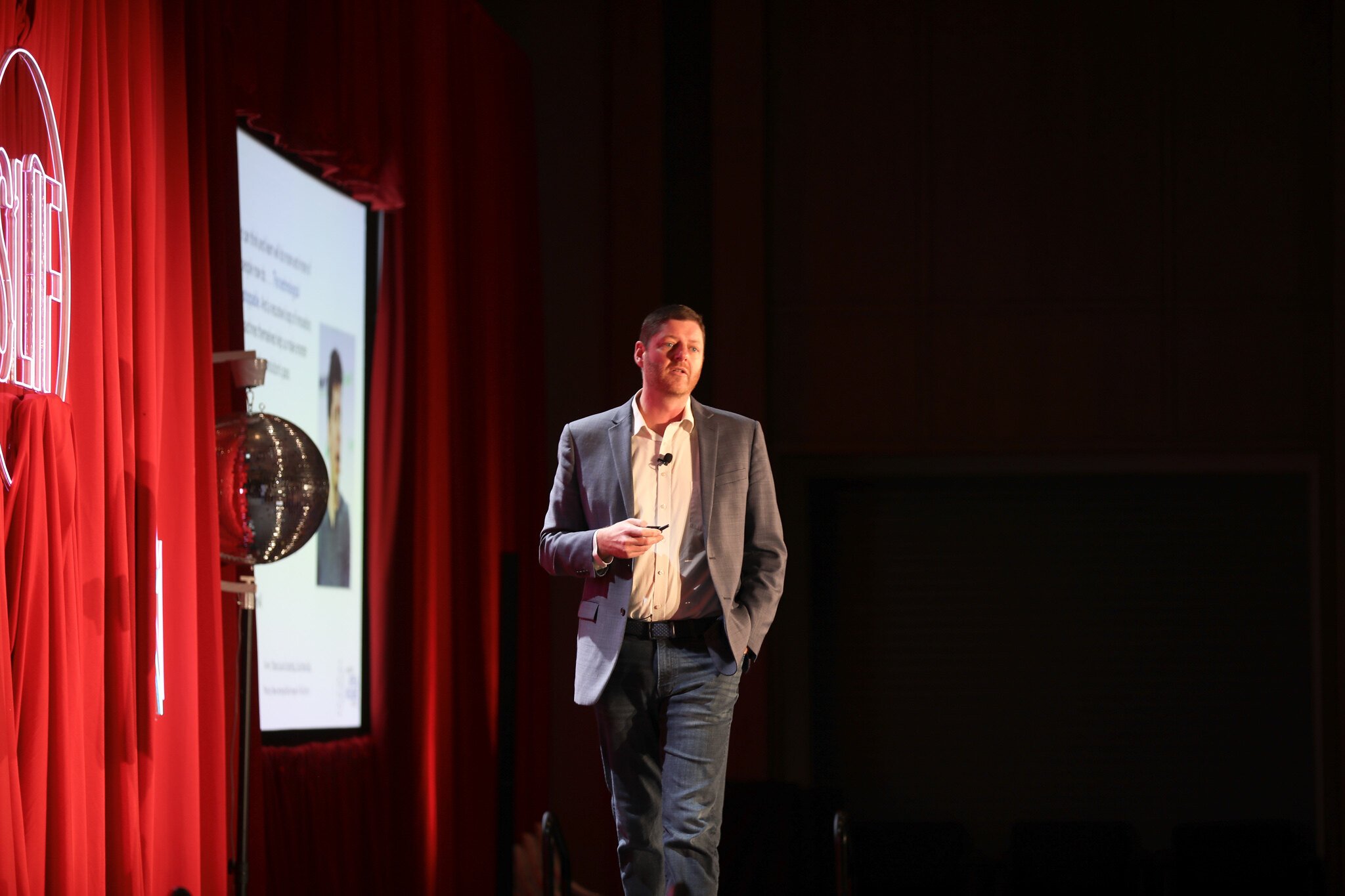Like pretty much everyone else in the world, we at SLIF have been blown away by recent advancements in generative artificial intelligence. When ChatGPT was first released back in December, we quickly realized we needed to find the right person to guide our audience through this breakthrough technology and its implications for the industry. That’s why we reached out to Paul Roetzer, Founder and CEO of the Marketing AI Institute, to speak at SLIF Spring in Austin, Texas.
What exactly is generative AI? What does it mean for senior living and for the world itself? What can operators do with it today, and what can they expect to do with it five years from now? Roetzer answered these questions and more in his illuminating presentation, followed by a Q+A session with SLIF attendees. “There aren't very many businesses prepared for what's about to happen,” he said. “There aren't many industries prepared for what's about to happen — and how quickly it's gonna happen.”
The Revolution Will Be Generative
By Roetzer’s estimation, there are already thousands of companies working on generative artificial intelligence: software that uses massive language models to generate text, images, and video. The revolution these companies are building may not reach senior living today or tomorrow, but it’s coming. If industry leaders wish to harness its power rather than get left in the dust, they’ll have to start preparing themselves now.
Paul Roetzer (Marketing AI Institute)
The good news is that they’re likely already familiar with the technology. “AI has been interwoven into your life for the last decade, and you probably just didn't even realize it,” Roetzer said. Gmail, YouTube, Google, Netflix, Amazon, LinkedIn, Zoom, Alexa: all these products use AI to make personalized suggestions, finish your sentences, predict your purchases, and generally make your life easier and more convenient. What’s about to change is the use of AI in business software, which by and large, hasn’t integrated the same level of innovation. In Roetzer’s eyes, we now sit at the base of an exponential curve whose heights we can’t even imagine.
“You look out ahead 12 months from now, two years from now, you think about the workforce, you think about the tech stack, you think about the processes you have, and you're gonna build them under what you know to be true,” he said. “The problem is the vast majority of what you know to be true is about to change.”
“Anywhere Language Is Generated”
For senior living operators, AI’s possibilities are endless. “Whether it's marketing, sales, service ops, HR, finance, wherever it is: anywhere language is generated, there are use cases for this kind of technology,” Roetzer explained. You can even use it to figure out how you can use it, which is exactly why Roetzer asked ChatGPT what use cases AI has for senior living providers. It quickly offered a litany of options: wellness programs tailored to individual residents' needs, personalized communications, cognitive games, and of course administrative busywork like scheduling, billing, and medication reminders.
As leaders consider where their businesses might benefit, they should consider where their operations depend on repetitive processes, use data to make decisions or predictions, or create content: all of these are areas where generative AI can shoulder the burden. And if companies like Figure succeed in their mission to build AI-powered humanoid robots, senior living providers may find themselves with a solution to the workforce crisis that’s straight out of a sci-fi movie. 
How can organizations figure out where AI might benefit them? Roetzer recommends two approaches. The first is a “problem-based model,” in which you identify pain points your organization is facing — “improving efficiency, driving costs down, increasing revenue, personalizing care and communications, recruiting and retaining talent” — and ask what it would be worth to solve them at scale with AI.
The second is a “use case model,” in which your team looks for pilot projects to deliver short-term wins. “If we could intelligently automate parts of this job — blogging, social media, sales, emails, customer service, whatever — how valuable would that be to us?” Roetzer asked, running through a list of considerations to factor into the equation. “How often you do it, how much time you spend on it, what tech you're currently using, how much you're spending on that; you could put labor in there to get a true cost. What's the value to intelligently automate?”
Data is the New Oil
One early use case for senior living: rudimentary care plans for residents with common profiles. The technology for this exists right now, according to Roetzer, though providers are likely to face challenges involving vendor-owned data. “If you want to have an intelligence engine that oversees your organization — that you can query at any moment to make a prediction or a recommendation — you would need all of that data,” he said. “Proprietary data is probably the most valuable asset you have. If it lives in silos and you can't make any predictions on it, then your first conversation is probably, ‘How do we centralize this data?’”
Then it’s just a matter of finding the right technology for an organization’s purposes, which doesn’t necessarily mean finding an AI specialist. “The key here is you're the expert at what you do,” Roetzer said. “What you do is you take what you're doing right now — your user story today — and say, ‘If I buy your software, what is my user story tomorrow? Is it gonna do 20% of the work for me? Fifty percent? What am I really going to get out of this?’” “You're just buying smarter technology,” he added. “What you're trying to arrive at is: ‘Once I have this solution, what is the machine going to do, and what am I the human going to do?’”
It’s a vital question to ask even if you’re skeptical of AI’s uses for your business, because it’s a question other businesses will be asking too. “It may take a couple of years depending on the industry, but over time you just can't compete with these kinds of companies.”
“The Moral Compass Has to Drive Your Organization”
Roetzer offered some advice for senior living providers dipping their toes into AI. First, he recommended organization-wide education and training, with a special focus on reassuring employees that they’re not being replaced with machines. “You have to start with a strategic approach to education and training, including the potential to eventually need to re-skill and up-skill some of your existing workforce,” he said. “None of this can happen until there's an understanding of what exactly it is.”

He also recommended that organizations create an internal AI council designed to discuss and codify best practices surrounding their own use of the technology. At the same time, they should develop department-specific policies, especially when it comes to sales and marketing. “You may have people using ChatGPT who don't even want to tell you they're using it,” Roetzer explained. “If you hire agencies to do some of your work and they're charging you by the hour, maybe they don't want you knowing that they're not spending the hour anymore, it's taking them three seconds instead.”
Intellectual property considerations come into play as well. The U.S. Copyright Office recently ruled that organizations don’t own materials created by AI, whether they’re images, video, or text. Not only does that mean other companies can use your AI-generated assets, it may also lead to ownership concerns if your contractors are using AI without your knowledge — especially if they’re doing it under work-for-hire agreements.
These concerns are likely just the tip of the iceberg, which is why organizations have to create and abide by their own principles. “The moral compass has to drive your organization, because law and regulations aren't going to catch up anytime soon,” Roetzer said.
His final recommendation? Create an internal AI roadmap for your business, identifying specific use cases and areas where you can infuse it. You may not be able to control how rapidly technology is developed or how eagerly it’s adopted by the senior living industry, but what you can control is your own plan for AI when it arrives.
“Look out three, five years from now,” Roetzer concluded. “Say, ‘How do we want to do this? What do we want to become?’ And have a vision for where that goes.”

Posted by
SLIF heads to Carlsbad!
The One of a Kind Retreat for Senior Housing Leaders.
May 31 - June 2, 2026 | Carlsbad, CA
Learn More









Comments